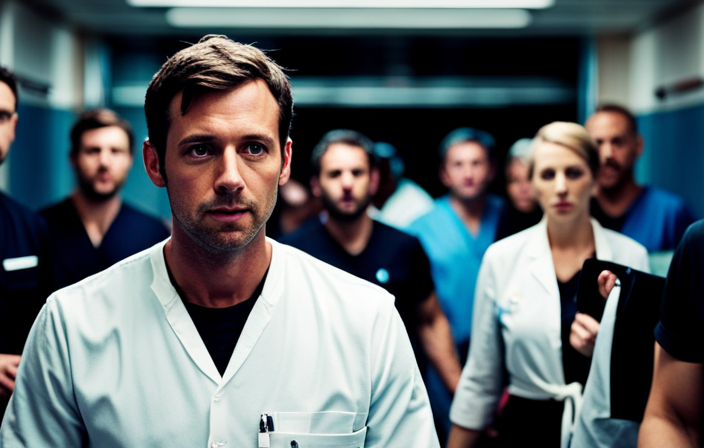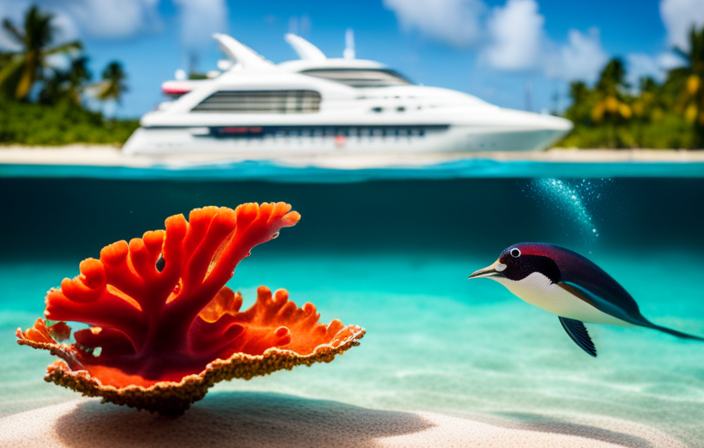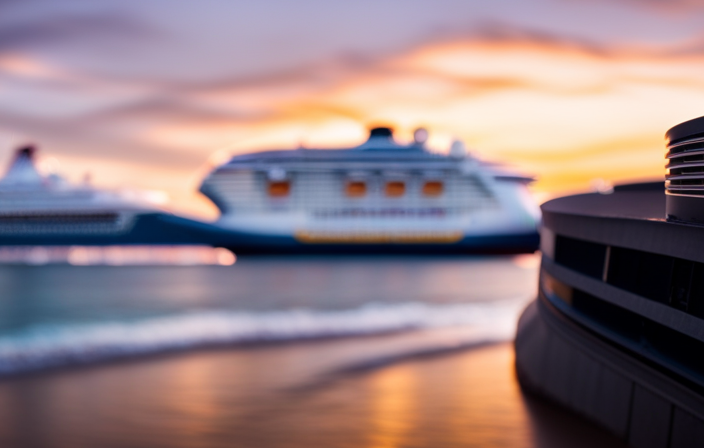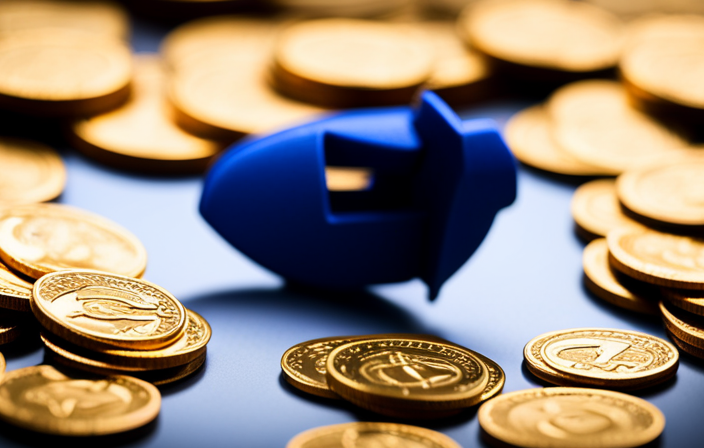As someone who loves to travel, I have always seen cruising as the best way to relax and explore. But it’s important to remember that medical emergencies can happen onboard. In this article, we will discuss the detailed and well-planned response that is put in place in case of such emergencies.
Onboard, the ship is equipped with advanced medical facilities and staffed with highly trained professionals who are ready to tackle any medical situation. Additionally, there is an efficient emergency response team that swings into action to ensure the swift and effective management of the situation. Communication and coordination with onshore medical facilities play a crucial role, guaranteeing seamless transfer of patients when necessary.
From medical drills to the availability of essential equipment and supplies, the cruise industry leaves no stone unturned in ensuring preparedness for emergencies. Furthermore, we will delve into the topics of insurance coverage, medical costs, and the methods of communicating with loved ones during such challenging times.
Lastly, we will explore the post-emergency support and follow-up care provided to passengers, as well as the valuable lessons learned and continuous improvement efforts in place. So, join me as we navigate the intricacies of what happens if there is a medical emergency on a cruise ship.
Key Takeaways
- Cruise ships have trained medical staff available 24/7 and fully equipped medical facilities on board to provide immediate care.
- Insurance coverage is important to protect against unexpected medical expenses and cruise lines often offer travel insurance with medical coverage.
- Communication with family and emergency contacts can be maintained through ship’s Wi-Fi, emergency contact numbers, social media, and messaging apps.
- After a medical emergency, coordination with medical professionals is crucial for further treatment and referrals to local hospitals or specialist consultations.
Onboard Medical Facilities and Staff
The onboard medical facilities and staff are well-equipped to handle any medical emergency that may arise during a cruise. The medical center on a cruise ship is staffed with qualified doctors, nurses, and other medical professionals who are trained in emergency medicine.
The facilities are equipped with state-of-the-art medical equipment, including X-ray machines, ultrasound devices, and a fully stocked pharmacy. In the event of a serious medical emergency, the ship’s medical team can provide immediate treatment and stabilize the patient.
If necessary, the ship has the capability for emergency evacuation, either by helicopter or by coordinating with local authorities at the next port of call. The medical staff works closely with the ship’s emergency response team to ensure a coordinated and efficient response to any medical situation that may arise.
Emergency Response Team
When you’re on a cruise, you’ll have a well-prepared team ready to handle any unexpected situations that may arise. The cruise ship’s emergency response team is composed of highly trained professionals who are equipped to handle medical emergencies at sea.
These individuals undergo rigorous emergency response training to ensure they are prepared for any situation that may occur. In the event of a medical emergency, the team is responsible for implementing medical evacuation procedures, which may involve airlifting the patient to a nearby hospital or coordinating with onshore medical facilities for further treatment.
This level of preparedness and expertise ensures that passengers receive the necessary medical care in a timely manner.
Transitioning into the subsequent section about communication and coordination with onshore medical facilities, the emergency response team plays a crucial role in facilitating this process.
Communication and Coordination with Onshore Medical Facilities
Stay connected and rest assured knowing that communication and coordination with onshore medical facilities are top priorities for your well-being during your cruise.
In the event of a medical emergency, the cruise ship’s medical team works closely with onshore medical facilities to provide the best possible care.
However, there may be communication challenges due to the ship’s remote location. To overcome these challenges, cruise ships are equipped with advanced communication systems. These systems allow for real-time remote medical consultations with onshore doctors. Such consultations enable the ship’s medical team to receive expert guidance and support, ensuring that passengers receive the appropriate medical attention.
Additionally, crew members undergo regular medical emergency drills and preparedness training. This training ensures a swift and efficient response in case of an emergency. It also ensures that the ship is well-prepared to handle any medical situation. As a result, passengers can have peace of mind throughout their cruise experience.
Medical Emergency Drills and Preparedness
Regular drills and simulations are an essential part of our preparedness for medical emergencies on board a cruise ship. These drills help us to assess our readiness, identify any gaps in our protocols, and improve our response times.
Additionally, we ensure that all crew members receive training on how to handle medical emergencies, including CPR, first aid, and the use of medical equipment, so that they can confidently and effectively respond to any situation that may arise.
Regular drills and simulations
During drills and simulations on a cruise ship, you’ll get to experience what it’s like to handle a medical emergency firsthand. These exercises are designed to prepare crew members for a variety of scenarios, from minor injuries to more serious medical conditions.
The medical emergency response team is trained to quickly assess the situation and provide necessary medical care. They follow established emergency evacuation procedures, ensuring the safety and well-being of all passengers.
These drills simulate real-life situations, allowing crew members to practice their skills and improve their response time. They learn how to effectively communicate with each other and coordinate their efforts during a medical emergency.
By participating in these drills, crew members gain valuable experience and confidence in handling medical emergencies. This training prepares them to handle any situation that may arise on a cruise ship, ensuring the safety and well-being of all passengers and crew members alike.
Training crew members to handle medical emergencies
Crew members on a cruise ship are extensively trained to handle any unexpected health situations that may arise. The safety and well-being of passengers is our top priority, which is why we invest significant time and effort in training our crew members in emergency preparedness. Here are three ways we ensure our crew members are prepared to handle medical emergencies:
-
Comprehensive training programs: Our crew members undergo rigorous training programs that cover a wide range of medical emergencies, including CPR, first aid, and basic life support. They are equipped with the knowledge and skills to provide immediate assistance to passengers in need.
-
Regular drills and simulations: We conduct regular drills and simulations to simulate various emergency situations. This helps our crew members practice their response and decision-making skills in a controlled environment, ensuring they are prepared for any real-life medical emergency.
-
Collaboration with medical professionals: We work closely with medical professionals to provide specialized training to our crew members. This includes training on specific medical procedures and protocols, ensuring that our crew members are well-equipped to handle even the most critical medical emergencies.
As crew members, we understand the importance of being prepared for any medical emergency that may occur on a cruise ship. With our extensive training and emergency preparedness, we are confident in our ability to provide the necessary care and support to passengers in need.
Moving forward, let’s explore the next section about the medical equipment and supplies available onboard to further enhance our emergency response capabilities.
Medical Equipment and Supplies
In case of a medical emergency on a cruise ship, you’ll be relieved to find that the ship is equipped with state-of-the-art medical equipment and supplies, ensuring that you receive the necessary care. The medical equipment inventory on board includes a variety of essential items, such as defibrillators, oxygen tanks, and ECG machines. Additionally, the ship maintains a well-stocked emergency medication supply, including common medications for various conditions. This ensures that the medical staff can promptly administer the required treatments. Here is an overview of the medical equipment and supplies available on a typical cruise ship:
| Equipment | Purpose |
|---|---|
| Defibrillators | To treat cardiac emergencies |
| Oxygen tanks | To provide respiratory support |
| ECG machines | To monitor heart activity |
With these resources readily available, the ship’s medical team can provide immediate and effective care. Now, let’s move on to the next section, which focuses on passenger safety and well-being.
Passenger Safety and Well-being
To ensure your safety and well-being on board, we have implemented comprehensive measures and protocols.
In the event of a medical emergency, our trained medical staff is available 24/7 to provide immediate assistance. We have fully equipped medical facilities on board, including state-of-the-art equipment and a wide range of medical supplies.
Our medical team is experienced in handling various medical situations and can provide initial treatment for a wide range of illnesses and injuries. In more serious cases, we have established protocols for medical evacuations, ensuring that passengers can receive the necessary care at a shore-side medical facility.
Our priority is to provide prompt and effective medical assistance to ensure the well-being of our passengers. In the unfortunate event of a medical emergency, we also recommend having insurance coverage to help with any potential medical costs.
Insurance and Medical Costs
Make sure you’re covered with insurance to protect yourself from unexpected expenses that could arise from any unforeseen circumstances. When it comes to medical emergencies on a cruise ship, insurance coverage is crucial.
Most cruise lines offer travel insurance that includes medical coverage, but it’s important to review the policy details to ensure it meets your needs. This insurance can help cover medical expenses, such as doctor visits, medications, and even emergency medical transportation if needed. However, keep in mind that there may still be out-of-pocket expenses depending on the policy limits and deductibles.
It’s essential to understand what is covered and what is not to avoid any surprises. Once you have insurance in place, you can have peace of mind knowing that you’re financially protected in case of a medical emergency.
Now, let’s discuss how to communicate with family and loved ones during such situations without causing unnecessary worry.
Communicating with Family and Loved Ones
Staying connected with family and loved ones is essential, even when unexpected situations arise, like on a cruise ship. In case of a medical emergency, it’s important to have a plan in place to communicate with your family and emergency contacts. Here are five ways to stay connected:
- Use the ship’s Wi-Fi or internet services to send updates and receive messages from your loved ones.
- Make sure to have emergency contact numbers readily available, both for your family and the cruise ship’s medical staff.
- Utilize social media platforms to share updates and let your family know about your situation.
- Consider purchasing an international calling card to make phone calls if needed.
- Use messaging apps like WhatsApp or Viber to send text messages and make voice or video calls.
Staying connected with family provides reassurance and support during a medical emergency.
Now let’s explore the importance of post-emergency support and follow-up care.
Post-Emergency Support and Follow-up Care
After a medical emergency on a cruise ship, it’s crucial to ensure continuity of care for the affected individual. This involves coordinating with medical professionals to ensure a smooth transition to further treatment, whether it be on the ship or on land.
Referrals and recommendations for additional medical support are also important to provide the necessary follow-up care and ensure the individual’s well-being.
Continuity of care after medical emergencies
In the chaotic aftermath of a medical emergency, ensuring seamless continuity of care becomes as crucial as a lifeline on a sinking ship. On a cruise ship, continuity of care faces unique challenges due to the remote nature of the vessel and limited medical resources available. To overcome these obstacles, cruise lines have adopted telemedicine technology, enabling remote medical consultations with onshore healthcare professionals. This allows for timely and accurate diagnosis, treatment, and follow-up care. To evoke an emotional response, consider the following table:
| Challenge | Solution |
|---|---|
| Limited access to specialized care | Telemedicine consultations with specialists |
| Language barriers | Onboard translators or remote translation services |
| Lack of medical history | Collaboration with patient’s home healthcare provider |
| Limited medical equipment | Coordination with onshore medical facilities |
These measures ensure that passengers receive the necessary care even in the middle of the ocean. Moving forward, referrals and recommendations for further treatment are vital to guarantee passengers’ well-being.
Referrals and recommendations for further treatment
To ensure passengers’ well-being, it is essential to facilitate referrals and recommendations for further treatment. In the event of a medical emergency on a cruise ship, it is important to provide passengers with appropriate follow-up care.
The ship’s medical staff should evaluate the situation and determine if the passenger requires additional treatment beyond what can be provided on board. Referrals can be made to local hospitals or healthcare facilities at the next port of call.
The medical staff should also provide recommendations for further treatment, including any necessary specialist consultations or procedures. This ensures that passengers receive the proper care they need to recover fully.
By ensuring that referrals and recommendations are made promptly and efficiently, cruise ship companies can prioritize the health and well-being of their passengers.
Transitioning into the subsequent section about ‘lessons learned and continuous improvement’, it is crucial to reflect on these processes to enhance future emergency response.
Lessons Learned and Continuous Improvement
Despite the challenges faced, the cruise industry has embraced the importance of continuous improvement in order to learn from past experiences and enhance safety measures in case of a medical emergency.
Lessons learned from previous incidents have paved the way for improvement strategies that aim to ensure the well-being of passengers and crew members. One key lesson is the importance of having well-trained medical staff on board who can handle emergencies efficiently. Cruise lines have recognized this and now prioritize the recruitment and training of medical professionals with diverse expertise.
Additionally, improved communication systems have been implemented to facilitate real-time contact between the ship and onshore medical facilities. This enables quicker and more effective coordination in case of an emergency.
Continuous improvement in medical equipment and technology is also a priority, ensuring that cruise ships are equipped with state-of-the-art medical facilities.
These ongoing efforts reflect the commitment of the cruise industry to prioritize the safety and well-being of all onboard.
Frequently Asked Questions
How often are medical drills conducted on cruise ships to ensure preparedness for medical emergencies?
Medical drills are conducted regularly on cruise ships to ensure preparedness for medical emergencies. The frequency of these drills varies, but they are designed to be effective in training the crew to respond promptly and effectively in emergency situations.
What types of medical equipment and supplies are available on cruise ships to handle various medical emergencies?
As a cruise ship nurse, I oversee a range of medical equipment and supplies. We have medications for common ailments, as well as emergency drugs. Our medical staff consists of qualified doctors and nurses who are trained to handle various medical emergencies.
Are there any specific safety measures in place to prevent medical emergencies from occurring on cruise ships?
Cruise ship medical staff, such as doctors and nurses, are highly qualified and trained to handle medical emergencies. If necessary, procedures are in place to quickly transfer patients to onshore medical facilities for further treatment.
What is the process for communicating with family and loved ones in the event of a medical emergency on a cruise ship?
In the event of a medical emergency on a cruise ship, the process for communication and contacting family and loved ones is swift and efficient, ensuring immediate updates and support during such critical situations.
How are post-emergency support and follow-up care provided to passengers who experience a medical emergency on a cruise ship?
After a medical emergency on a cruise ship, passengers receive post-emergency support and follow-up care. This includes medical evaluations, treatment plans, and assistance with any necessary medical procedures or arrangements for further care.
Conclusion
So there you have it, folks! Now you know all about what happens if there’s a medical emergency on a cruise ship.
From the highly trained onboard medical staff to the efficient emergency response team, they’ve got you covered.
And don’t worry about communication – they’ve got that covered too, with their coordination with onshore medical facilities.
Plus, they even have medical drills and preparedness to ensure they’re ready for anything.
Just remember to pack your insurance card and be prepared for some hefty medical costs. But hey, at least you’ll have a great story to tell your family and loved ones when you finally get back on land.
And if all else fails, they’ll provide you with post-emergency support and follow-up care.
So sit back, relax, and enjoy your cruise – medical emergencies and all!










